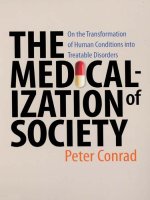the johns hopkins university press the medicalization of society on the transformation of human conditions into treatable disorders apr 2007
Bạn đang xem bản rút gọn của tài liệu. Xem và tải ngay bản đầy đủ của tài liệu tại đây (1.51 MB, 220 trang )
The Medicalization of Society
This page intentionally left blank
The Medicalization of Society
On the Transformation of Human Conditions
into Treatable Disorders
peter conrad
The Johns Hopkins University Press
Baltimore
© 2007 The Johns Hopkins University Press
All rights reserved. Published 2007
Printed in the United States of America on acid-free paper
246897531
The Johns Hopkins University Press
2715 North Charles Street
Baltimore, Maryland 21218-4363
www.press.jhu.edu
Library of Congress Cataloging-in-Publication Data
Conrad, Peter, 1945–
The medicalization of society : on the transformation of human
conditions into treatable disorders / Peter Conrad.
p. ; cm.
Includes bibliographical references and index.
ISBN-13: 978-0-8018-8584-6 (hardcover : alk. paper)
ISBN-10: 0-8018-8584-1 (hardcover : alk. paper)
ISBN-13: 978-0-8018-8585-3 (pbk. alk. paper)
ISBN-10: 0-8018-8585-X (pbk. alk. paper)
1. Social medicine—History. I. Title.
[DNLM: 1. Sociology, Medical—trends. WA 31 C754m 2007]
RA418.C686 2007
362.1—dc22
2006033235
A catalog record for this book is available from the British Library.
For Irving Kenneth Zola (1935–1994)—
Pioneer in the study of medicalization,
inspiring colleague, and good friend
This page intentionally left blank
Contents
Preface ix
Acknowledgments xiii
part i concepts
1 Medicalization: Context, Characteristics, and Changes 3
part ii cases
2 Extension: Men and the Medicalization of
Andropause, Baldness, and Erectile Dysfunction 23
3 Expansion: From Hyperactive Children to Adult ADHD 46
4 Enhancement: Human Growth Hormone and the
Temptations of Biomedical Enhancement 70
5 Continuity: Homosexuality and the
Potential for Remedicalization 97
part iii constraints and consequences
6 Measuring Medicalization: Categories, Numbers, and Treatment 117
7 The Shifting Engines of Medicalization 133
8 Medicalization and Its Discontents 146
Notes 165
References 171
Index 197
This page intentionally left blank
Preface
I have been interested in the medicalization of society for a long time. My Ph.D.
dissertation was a participant observation study of the medicalization of hyperactiv-
ity in children (Conrad, 1976). This was followed by a more historical account of
the medicalization of deviance, coauthored with Joseph Schneider (Conrad and
Schneider, 1980). Then, after a decade studying other sociological issues, I again
turned my attention to medicalization with a review article on medicalization and
social control (Conrad, 1992). For nearly another decade, I didn’t write much on
medicalization, until I wrote a piece that fused my research on the public discourse
of genetics with medicalization (Conrad, 2000).
Approaching the millennium, it was becoming clear to me that there were sig-
nificant changes occurring around medicalization, and my interest, which had
never waned, was piqued again. My intellectual focus had grown beyond deviance,
so I knew I wanted to study the broader issues around medicalization. My first
thought was to write a comprehensive account of medicalization, reviewing and
integrating everything that had been written on the subject, a kind of medicalization
magnum opus. Once I started delving into the literature, it was clear that this was
too large a task. Simply too many human problems have been medicalized and
too many scholars—historians, sociologists, anthropologists, physicians, feminists,
bioethicists, and others—had examined pieces of it to fit in one book.
But I felt it was time for a new sociological examination of medicalization, and I
settled on examining the key writings on the subject and focusing my analysis on a
number of cases that reflected different aspects of medicalization. My goal would be
not comprehensive but strategic with respect to the cases I would examine and the
medicalization issues I would raise. I have always been most comfortable looking at
problems inductively, from the case to the more general conceptual understanding.
I would use these cases to develop a greater understanding about the changes in
medicalization, especially as they have occurred in the past three-plus decades.
In general, I chose cases that interested me. There are certainly many important
instances of medicalization that I could have examined—-obesity, reproduction,
sleep problems, myriad addictions, the expansion of depression or post-traumatic
stress disorder, just to name a few—but I selected cases that seemed to reflect on sig-
nificant changes in medicalization. My approach was to study the cases one by one
and to engage graduate students as collaborators in the process. This has been a most
rewarding experience and has resulted in a number of coauthored publications,
which I note in the acknowledgments. These cases allow me to examine certain
facets of medicalization: extension of medicalization, expansion of existing cate-
gories, biomedical enhancement as medicalization, and the continuity of a classic
case of demedicalization. I built on these cases, intertwining other examples, to
develop some new conceptual understandings. These are seen most clearly in the
final two chapters of this book and in a separate article (Conrad and Leiter, 2004).
So now, after more than thirty years as a student of medicalization, I am more
convinced than ever that this is a subject of great sociological significance and an
accelerating trend that has important implications for society. I hope that this book
will shed new light the topic and encourage others to examine the issues further.
Chapter 1 describes the characteristics of medicalization, briefly reviewing the
rise of medicalization and some ongoing controversies, outlining some of the
changes in medicine in the past twenty years, and introducing the importance of the
creation of markets for medicalization. The next four chapters examine specific
cases of medicalization, each with a particular conceptual issue: extension of med-
icalization from one to both genders; diagnostic expansion of a specific malady to
encompass more populations; biomedical enhancement as a form of medicaliza-
tion; and the potential for remedicalization. The final three chapters analyze the
measurement of medicalization, the shifting engines that drive this phenomenon,
and some of the consequences of medicalization for medicine, patients, and society.
The second through fourth chapters examine both the creation of a demand for
new medical products and the roles played by the pharmaceutical industry, physi-
cians, consumers, and insurers in the emergence of medical markets and the med-
icalization of human problems. Until recently, women’s problems were much more
likely to be medicalized than men’s. Chapter 2 examines three recent cases in which
men have increasingly been seen as a market for medical products. As a result,
andropause, baldness, and erectile dysfunction have been medicalized to different
degrees. Chapter 3 examines the rise of adult attention-deficit/hyperactivity disorder
to demonstrate how an extant medical category can expand to include an entirely
new population of people (adults) for what was considered largely a disorder of chil-
dren and adolescents. This type of diagnostic expansion has its roots in medical
claims-makers, consumer demands, and the growing markets of the pharmaceutical
x preface
industry. It is increasingly evident that the potential of biomedical enhancement will
increase medicalization. Chapter 4 analyzes the case of human growth hormone,
which has been at various times proposed as a medical enhancement for idiopathic
short stature, aging, and athletic performance. Such biomedical enhancement is a
particular form of medicalization that is likely to increase as science (especially genet-
ics) develops new interventions to “improve” body and performance that are tempt-
ing to consumers and profitable for biotechnology companies. Chapter 5 first reviews
the important example of the demedicalization of homosexuality and then evaluates
the impact of several changes in medical knowledge, the gay and lesbian movement,
and society that could lead to a remedicalization. While medical markets play a
smaller role, biotechnology may still be a catalyst for remedicalization.
The next three chapters focus on issues that are more general to medicalization.
Chapter 6 takes on the issue of measuring medicalization: how much medicaliza-
tion is there, and how can we measure it? The growing number of medicalized cat-
egories indicates that medicalization is expanding, yet numbers are hard to locate.
This chapter presents three ways to estimate increasing amounts of medicalization.
Chapter 7 focuses on the emergent engines of medicalization. In the past thirty
years, the driving forces behind medicalization have shifted from the medical pro-
fession, social movements, and inter- or intraorganizational conflicts to biotechnol-
ogy, consumers, and managed care. In this chapter I focus on the importance of the
creation of medical markets for medicalization. Chapter 8, the final chapter, ana-
lyzes some of the consequences of medicalization for our culture, society, medicine,
and patients/consumers. In part in response to the spread of medicalization and its
implications, pockets of resistance to medicalization have emerged, and these may
be harbingers for the future.
preface xi
This page intentionally left blank
Acknowledgments
I have researched and written about medicalization on and off for more than
thirty years. In that time I have garnered many intellectual debts, far too many for
me to remember and thank here. So here I will acknowledge and thank those many
individuals who have aided the research, writing, and analysis of this book.
Earlier versions of several chapters first appeared as articles published in books or
journals. Several of these were coauthored with some of the splendid students I have
had the privilege to teach and work with at Brandeis University. Most of chapter 2
appeared first in a chapter coauthored with Julia Szymczak with part from another
article written with Valerie Leiter; chapters 3 and 4 appeared first in slightly differ-
ent form and were coauthored with Deborah Potter; chapter 5 was published in a
shorter form coauthored with Alison Angell; a section of chapter 6 comes from col-
laborative work with colleagues Cindy Parks Thomas and Elizabeth Goodman and
with Rosemary Casler; a small part of chapter 7 was coauthored with Valerie Leiter.
Research done with Cheryl Stults and Heather Jacobson appears in chapter 6. I
want to thank all of these students and colleagues for their contributions to this vol-
ume. I literally couldn’t have done it without them. I hope they are pleased with
how the work has been updated for the book.
I also want to thank Sharon Hogan, who was a great adviser and editor in help-
ing me turn published journal articles into some of the core chapters of this book,
and Elizabeth Ginsburg, for organizing and tracking down citations and references.
I also thank Wendy Harris, my editor at Johns Hopkins University Press, for her sup-
port and patience while I was working to meet deadlines to complete the book. I am
grateful to Mary V. Yates for her careful copy-editing.
A number of colleagues read chapters or excerpts at the manuscript stage and
provided useful comments, which I most often heeded to the benefit of the book.
These include Renee Anspach, Charles Bosk, Phil Brown, Michael Bury, Steve
Epstein, Emily Kolker, Allan Horwitz, Susan Markens, Peter Nardi, Dana Rosenfeld,
and Stefan Timmermans. I thank all these friends and colleagues and apologize in
advance to anyone I inadvertently left out. None of these generous people is respon-
sible for any shortcomings that remain.
Some of the material in this volume was previously published. I acknowledge the
original publication outlets for permission to include the material here. Chapter 1
includes material that was published in the Annual Review of Sociology, The Hand-
book of Medical Sociology (Prentice Hall), and Journal of Health and Social Behavior;
chapter 2 appeared in a different form in Medicalized Masculinities (Temple Uni-
versity Press) and Journal of Health and Social Behavior; chapters 3 and 4 appeared
in a slightly different form in Social Problems and Sociology of Health and Illness;
chapter 5 appeared in a much shorter and less fully developed form in Society; a sec-
tion of chapter 6 is based on research we published in Psychiatric Services; an ear-
lier version of chapter 7 appeared in Journal of Health and Social Behavior; and a
few paragraphs in chapter 8 were published in Annual Review of Sociology and The
Handbook of Medical Sociology. Thanks to all the publishers for allowing me to
reprint and update the material here.
I want to acknowledge Brandeis University for a supportive academic environ-
ment, for several Mazer Faculty Grants, and for providing a sabbatical leave that
greatly moved the project forward.
Finally, I thank my family for love and support, and especially my wife, Libby
Bradshaw, who is at once a knowledgeable and sensible physician, a sounding board
(and sometime critic) for my ideas, and a great life partner.
xiv acknowledgments
Concepts
part one
This page intentionally left blank
Medicalization
Context, Characteristics, and Changes
chapter one
When I began teaching medical sociology in the 1970s, the terrain of health and
illness looked quite different from what we find in the early twenty-first century. In
my classes, there was no mention of now-common maladies such as attention-
deficit/hyperactivity disorder (ADHD), anorexia, chronic fatigue syndrome (CFS),
post-traumatic stress disorder (PTSD), panic disorder, fetal alcohol syndrome, pre-
menstrual syndrome (PMS), and sudden infant death syndrome (SIDS), to name
some of the most prevalent. Neither obesity nor alcoholism was widely viewed in the
medical profession as a disease. There was no mention of diseases like AIDS or con-
tested illnesses like Gulf War syndrome or multiple chemical sensitivity disorder.
While Ritalin was used with a relatively small number of children and tranquilizers
were commonly prescribed for certain problems, human growth hormone (hGH),
Viagra, and antidepressants like selective serotonin reuptake inhibitors (SSRIs) were
not yet produced.
In the past thirty years or so, medical professionals have identified several prob-
lems that have become commonly known illnesses or disorders. In this book I ad-
dress illnesses or “syndromes” that relate to behavior, a psychic state, or a bodily con-
dition that now has a medical diagnosis and medical treatment. Clearly, the number
of life problems that are defined as medical has increased enormously. Does this
mean that there is a new epidemic of medical problems or that medicine is better
able to identify and treat already existing problems? Or does it mean that a whole
range of life’s problems have now received medical diagnoses and are subject to
medical treatment, despite dubious evidence of their medical nature?
I am not interested in adjudicating whether any particular problem is really a
medical problem. That is far beyond the scope of my expertise and the boundaries
of this book. I am interested in the social underpinnings of this expansion of med-
ical jurisdiction and the social implications of this development. We can examine
the medicalization of human problems and bracket the question of whether they are
“real” medical problems. What constitutes a real medical problem may be largely
in the eyes of the beholder or in the realm of those who have the authority to define
a problem as medical. In this sense it is the viability of the designation rather than
the validity of the diagnosis that is grist for the sociological mill.
The impact of medicine and medical concepts has expanded enormously in the
past fifty years. To take just two common indicators, the percentage of our gross na-
tional product spent on health care has increased from 4.5 percent in 1950 to 16 per-
cent in 2006, and the number of physicians has grown from 148 per 100,000 in 1970 to
281 per 100,000 in 2003 (Kaiser Family Foundation, 2005: Exhibit 5-7). The number
of physicians per population nearly doubled in that period, greatly extending medical
capacity. In this same period the jurisdiction of medicine has grown to include new
problems that previously were not deemed to fall within the medical sphere.
“Medicalization” describes a process by which nonmedical problems become
defined and treated as medical problems, usually in terms of illness and disorders.
Some analysts have suggested that the growth of medical jurisdiction is “one of the
most potent transformations of the last half of the twentieth century in the West”
(Clarke et al., 2003: 161). For nearly four decades, sociologists, anthropologists, his-
torians, bioethicists, physicians, and others have written about medicalization (Bal-
lard and Elston, 2005). These analysts have focused on the specific instances of med-
icalization, examining the origins, range, and impact of medicalization on society,
medicine, patients, and culture (Conrad, 1992; Bartholomew, 2000; Lock, 2001).
While some have simply examined the development of medicalization, most have
taken a somewhat critical or skeptical view of this social transformation.
In this chapter I examine some of the issues concerning medicalization and so-
cial control. Rather than summarizing the literature, I emphasize conceptual and
substantive issues regarding medicalization. In doing so I make no attempt to pro-
vide a comprehensive review. Elsewhere I have reviewed some of the writings on
medicalization more completely (Conrad, 1992, 2000).
characteristics of medicalization
Sociologists have studied medicalization since the late 1960s. The first studies fo-
cused on the medicalization of deviance (Pitts, 1968; Conrad, 1975), but soon the con-
cept was seen to be applicable to a wide range of human problems that had entered
medical jurisdiction (Freidson, 1970; Zola, 1972; Illich, 1976). To estimate the amount
4 concepts
of work that has been done on medicalization, I searched several databases with the key-
word “medicalization.” While the results of this search (see table 1.1) are only rough in-
dices, they give a general sense of the amount of attention and writing given to this
topic. In sociology alone there are dozens of case examples of medicalization; the cor-
responding body of literature has loosely been called the “medicalization thesis” (Bal-
lard and Elston, 2005) or even “medicalization theory” (Williams and Calnan, 1996).
Medicalization also has gained attention beyond the social sciences. Numerous
articles may be identified in a Medline search (of the medical literature), but of par-
ticular interest are the British Medical Journal (2002) special issue devoted to med-
icalization and an issue of PLoS Medicine (2006) largely devoted to “disease mon-
gering.” In 2003 the President’s Council on Bioethics dedicated an entire session to
examining medicalization (Kass et al., 2003). Less attention has been given to med-
icalization in the news, although the number of popular news references to med-
icalization has increased in the past couple of years. In 2005, for instance, the Seat-
tle Times published a five-part investigative series entitled “Suddenly Sick” that
focused on the promotion of illness categories and medicalization (Kelleher and
Wilson, 2005). It seems evident that interest in and research on medicalization is
growing as medicalization itself is increasing.
The key to medicalization is definition. That is, a problem is defined in medical
terms, described using medical language, understood through the adoption of a
medical framework, or “treated” with a medical intervention. While much writing,
including my own, has been critical of medicalization, it is important to remember
that medicalization describes a process. Thus, we can examine the medicalization
of epilepsy, a disorder most people would agree is “really” medical, as well as we can
examine the medicalization of alcoholism, ADHD, menopause, or erectile dys-
function. While “medicalize” literally means “to make medical,” and the analytical
emphasis has been on overmedicalization and its consequences, assumptions of over-
medicalization are not a given in the perspective. The main point in considering
medicalization is that an entity that is regarded as an illness or disease is not ipso facto
medicalization 5
Table 1.1
Searches on Medicalization, August 25, 2005
Google 71,700
Google Scholar 4,130 results
Social Sciences Citation Index 530 articles
Medline 445 articles
Social Science Abstracts 179 articles
Newspaper Abstracts 21 articles
a medical problem; rather, it needs to become defined as one. While the medical
profession often has first call on most maladies that can be related to the body and to
a large degree the psyche (Zola, 1972), some active agents are necessary for most prob-
lems to become medicalized (Conrad, 1992; Conrad and Schneider, 1992).
Many of the earliest studies assumed that physicians were the key to understand-
ing medicalization. Illich (1976) used the catchy but misleading phrase “medical
imperialism.” It soon became clear, however, that medicalization was more com-
plicated than the annexation of new problems by doctors and the medical profes-
sion. In cases like alcoholism, medicalization was primarily accomplished by a so-
cial movement (Alcoholics Anonymous), and physicians were actually late adopters
of the view of alcoholism as a disease (Conrad and Schneider, 1992). And even to
this day, the medical profession or individual doctors may be only marginally in-
volved with the management of alcoholism, and actual medical treatments are not
requisite for medicalization (Conrad, 1992; Appleton, 1995).
Although medicalization occurs primarily with deviance and “normal life
events,” it cuts a wide swath through our society and encompasses broad areas of hu-
man life. Among other categories, the medicalization of deviance includes alco-
holism, mental disorders, opiate addictions, eating disorders, sexual and gender dif-
ference, sexual dysfunction, learning disabilities, and child and sexual abuse. It also
has spawned numerous new categories, from ADHD to PMS to PTSD to CFS. Be-
haviors that were once defined as immoral, sinful, or criminal have been given med-
ical meaning, moving them from badness to sickness. Certain common life processes
have been medicalized as well, including anxiety and mood, menstruation, birth
control, infertility, childbirth, menopause, aging, and death.
The growth of medicalized categories suggests an increase in medicalization (see
chapter 6), but this growth is not simply a result of medical colonization or moral en-
trepreneurship. Arthur Barsky and Jonathan Boros point out that the public’s toler-
ance of mild symptoms has decreased, spurring a “progressive medicalization of phys-
ical distress in which uncomfortable body states and isolated symptoms are reclassified
as diseases” (1995: 1931). Social movements, patient organizations, and individual pa-
tients have also been important advocates for medicalization (Broom and Woodward,
1996). In recent years corporate entities like the pharmaceutical industry and poten-
tial patients as consumers have begun to play more significant roles in medicalization.
Medicalization need not be total; thus, we can say there are degrees of medical-
ization. Some cases of a condition may not be medicalized, competing definitions
may exist, or remnants of a previous definition may cloud the picture. Some condi-
tions such as death, childbirth, and severe mental illness are almost fully medical-
ized. Others, such as opiate addiction and menopause, are partly medicalized. Still
6 concepts
others, such as sexual addiction and spouse abuse, are minimally medicalized.
While we don’t know specifically which factors affect the degrees of medicalization,
it is likely that support of the medical profession, discovery of new etiologies, avail-
ability and profitability of treatments, coverage by medical insurance, and the pres-
ence of individuals or groups who promote or challenge medical definitions may all
be significant in particular cases. There are also constraints on medicalization, in-
cluding competing definitions, costs of medical care, absence of support in the med-
ical profession, limits on insurance coverage, and the like. Medical categories can
shift on the continuum toward or away from more complete medicalization.
Medical categories can also expand or contract. One dimension of the degree of
medicalization is the elasticity of a medical category. “While some categories are
narrow and circumspect, others can expand and incorporate a number of other
problems” (Conrad, 1992: 221). For example, Alzheimer disease (AD) was once an
obscure disorder, but with the removal of “age” as a criterion (P. Fox, 1989) there
was no longer a distinction between AD and senile dementia. This change in defi-
nition to include cases of senile dementia in the population of adults over 60 years
old sharply increased the number of cases of AD. As a result, AD has become one of
the top five causes of death in the United States (cf. Bond, 1992). Medicalization by
diagnostic expansion will be examined in chapter 3.
Medicalization is bidirectional, in the sense that there can be both medicaliza-
tion and demedicalization, but the trend in the past century has been toward the ex-
pansion of medical jurisdiction. For demedicalization to occur, the problem must
no longer be defined in medical terms, and medical treatments can no longer be
deemed appropriate interventions. A classic example is masturbation, which in the
nineteenth century was considered a disease and worthy of medical intervention
(Engelhardt, 1974) but by the mid-twentieth century was no longer seen as requir-
ing medical treatment. In a somewhat different vein, the disability movement has
advocated, with partial success, for a demedicalization of disability and a reframing
of it in terms of access and civil rights (Oliver, 1996). The most notable example is
homosexuality, which was officially demedicalized in the 1970s; in chapter 5 I ex-
amine the possibilities of its remedicalization. Childbirth, by contrast, has been rad-
ically transformed in recent years with “natural childbirth,” birthing rooms, nurse
midwives, and a host of other changes, but it has not been demedicalized. Child-
birth is still defined as a medical event, and medical professionals still attend it.
Birthing at home with lay midwives approaches demedicalization, but it remains
rare. In general, there are few contemporary cases of demedicalization to examine.
Critics have been concerned that medicalization transforms aspects of everyday
life into pathologies, narrowing the range of what is considered acceptable. Med-
medicalization 7
icalization also focuses the source of the problem in the individual rather than in the
social environment; it calls for individual medical interventions rather than more col-
lective or social solutions. Furthermore, by expanding medical jurisdiction, medical-
ization increases the amount of medical social control over human behavior. Early crit-
ics warned that medical social control would likely replace other forms of social control
(Pitts, 1968; Zola, 1972), and while this has not occurred, it can be argued that medical
social control has continued to expand. Although many definitions of medical social
control have been offered, I still contend that “the greatest social control power comes
from having the authority to define certain behaviors, persons and things” (Conrad and
Schneider, 1992: 8). Thus, in general, the key issue remains definitional—the power to
have a particular set of (medical) definitions realized in both spirit and practice. More
recently critics have emphasized how medicalization has increased the profitability
and markets of pharmaceutical and biotechnological firms (Moynihan and Cassels,
2005); these trends are discussed in later chapters. A fuller discussion of the social im-
plications of the medicalization of society is found in chapter 8.
the rise of medicalization
Analysts have long pointed to social factors that have encouraged or abetted med-
icalization: the diminution of religion; an abiding faith in science, rationality, and
progress; the increased prestige and power of the medical profession; the American
penchant for individual and technological solutions to problems; and a general hu-
manitarian trend in Western societies. These factors, rather than being explanatory,
set the context in which medicalization occurs.
Most early sociological studies took a social constructionist tack in investigating
the rise of medicalization. The focus was on the creation (or construction) of new
medical categories with the subsequent expansion of medical jurisdiction. Con-
cepts such as moral entrepreneurs, professional dominance, and claims-making
were central to the analytical discourse. Studies of the medicalization of hyper-
activity, child abuse, menopause, post-traumatic stress disorder, and alcoholism,
among others, broadened our understanding of the range of medicalization and its
attendant social processes (see Conrad, 1992). Michel Foucault (e.g., 1965), one of
the great social analysts of the latter twentieth century, did not typically use the term
“medicalization” but tended “to present a consonant vision that shows the impact of
medical discourses on peoples lives” (Lupton, 1997: 94). But most studies of med-
icalization tend to be social constructionist rather than Foucauldian in orientation.
If one conducted a meta-analysis of the studies from the 1970s and 1980s, several
social factors would predominate. At the risk of oversimplification, I suggest that
8 concepts
three factors underlie most of those analyses. First, there was the power and author-
ity of the medical profession, whether in terms of professional dominance, physician
entrepreneurs, or, in its extremes, medical colonization. Here the cultural or pro-
fessional influence of medical authority is critical. One way or another, the medical
profession and the expansion of medical jurisdiction were prime movers for med-
icalization. This powerful medical authority was evident in the medicalization of
hyperactivity, menopause, child abuse, and childbirth, among others. Second, med-
icalization sometimes occurred through the activities of social movements and in-
terest groups. In these cases, organized efforts were made to champion a medical
definition of a problem or to promote the veracity of a medical diagnosis. The clas-
sic example is alcoholism, with both Alcoholics Anonymous and the “alcoholism
movement” central to medicalization of the condition (with physicians reluctant,
resistant, or irresolute). Social movements were also critical in the medicalization of
PTSD (W. Scott, 1990) and Alzheimer disease (P. Fox, 1989). Some efforts were less
successful, as in the case of multiple chemical sensitivity disorder (Kroll-Smith and
Floyd, 1997) and sexual addiction (J. Irvine, 1995). In general, organized grassroots ef-
forts promoted medicalization. Third, directed organizational or inter- or intrapro-
fessional activities promulgated medicalization, where professions competed for au-
thority in defining and treating problems, as was the case with obstetricians and the
demise of midwives (Wertz and Wertz, 1989) or the rise of behavioral pediatrics in
the wake of medical control of childhood diseases (Pawluch, 1983; Halpern, 1990).
Far from medical imperialism, medicalization is a form of collective action. While
physicians and the medical profession have historically been central to medicalization,
doctors are not simply colonizing new problems or labeling feckless patients. Patients
and other laypeople can be active collaborators in the medicalization of their problems
or downright eager for medicalization (e.g., Becker and Nachtigall, 1992), although
sympathetic professionals are usually needed for successful claims-making (Brown,
1995). Studies demonstrate the importance of the mobilization of people who are di-
agnosed in collectively promoting and shaping their diagnoses (e.g., Riessman, 1983).
This kind of diagnostic advocacy is often accomplished in some association or con-
nection with an extant social movement: PMS with the women’s movement (Riess-
man, 1983; Figert, 1995); PTSD with the Vietnam veterans movement (W. Scott, 1990);
and AIDS treatment with the gay and lesbian movement (Epstein, 1996). In each case
the explicit politicization and mobilization of the social movement propelled the new
category forward. Self-help and patient advocacy groups are legion, and some have
promoted the acceptance of their own illness categories (Rossol, 2001; Barker, 2002).
To be sure, other contributing factors were implicated in the analyses. Pharma-
ceutical innovations and the marketing of Ritalin and hormone replacement therapy
medicalization 9
(HRT) played a role in the medicalization of hyperactivity and menopause. Third-
party payers (i.e., the health insurers that would pay for treatment) were factors in
the medicalization of “gender dysphoria,” obesity, and the detoxification and med-
ical treatment for alcoholism. However, it is significant that in virtually all studies
where they were considered, the corporate players in medicalization were deemed
secondary to professionals, patient movements, or other claims-makers. By and
large, the pharmaceutical and insurance industries were not central to the analyses.
Medicalization studies by sociologists and feminist scholars have shown how
women’s problems have been disproportionately medicalized. This is manifested in
studies of reproduction and birth control, childbirth, infertility, premenstrual syn-
drome, fetal alcohol syndrome, eating disorders, sexuality, menopause, cosmetic
surgery, anxiety, and depression. Catherine Kohler Riessman (1983) and Elianne
Riska (2003) incisively examined the particular gendered aspects of medicalization.
While the medicalization of women’s bodies and difficulties continues (Lock,
2004), as discussed in chapter 2, men, especially aging male bodies, are now also be-
ing increasingly medicalized. While medicalization is not yet gender equal, it seems
to be moving in that direction (e.g., Rosenfeld and Faircloth, 2006).
controversies and critiques
Studies of medicalization have not been without controversy.
1
These controver-
sies are important to moving the study of medicalization forward. But readers not in-
terested in what may seem to be internal academic debates can skip this section and
move to the next one. For those who stay the course there is the promise of a greater
understanding of the contours of the medicalization process.
The earliest critiques argued that the medicalization case has been overstated and
that significant constraints limit rampant medicalization (R. Fox, 1977; Strong, 1979).
Some of these critiques conflated deprofessionalization with demedicalization (R. Fox,
1977). Others failed to recognize that most studies of medicalization adopt a histori-
cal, social-constructionist perspective. This perspective focuses on the emergence of
medical categories and how problems entered the medical domain, bracketing
whether a phenomenon is “really” a medical problem (Bury, 1986; see Conrad, 1992:
212). From a sociological perspective, case studies of medicalization have created a
new understanding of the social process involved in the cultural production of med-
ical categories or knowledge; however, these investigations do not necessarily contain
a mandate as to how the categories and knowledge are to be evaluated.
In the 1990s several writers suggested ways of “rethinking” or “reconsidering”
medicalization. For example, some noted how changes in society and medicine
10 concepts









